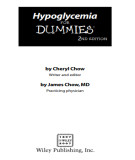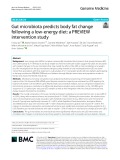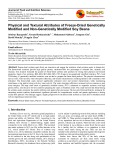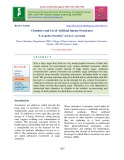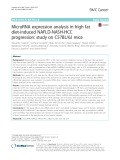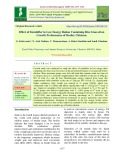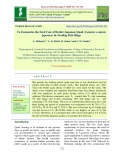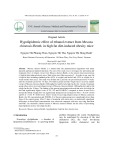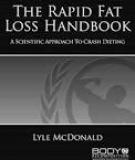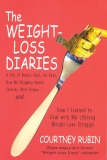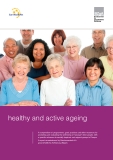
Low fat diet
-
Since the first edition of Hypoglycemia For Dummies came out in 2002, many more studies have been published on how foods affect your health. Although the basic hypoglycemia diet remains the same, we know much more than we did about the effect of different fats on the body. At the same time, more light has been cast on the dangers of artificial sweeteners and monosodium glutamate (MSG).
 290p
290p  zizaybay1104
zizaybay1104
 29-05-2024
29-05-2024
 330
330
 2
2
 Download
Download
-
Low-energy diets (LEDs) comprise commercially formulated food products that provide between 800 and 1200 kcal/day (3.3–5 MJ/day) to aid body weight loss. Recent small-scale studies suggest that LEDs are associated with marked changes in the gut microbiota that may modify the effect of the LED on host metabolism and weight loss.
 18p
18p  viellison
viellison
 28-03-2024
28-03-2024
 4
4
 2
2
 Download
Download
-
Background and Aims- To evaluate the impact of nutritional intervention on vitamins and minerals from intake food and anthropometric parameters at overweight and obese patients. Material and methods- To a sample of 40 overweight and obese patients we evaluated the nutritional content of food intake (kilocalories, macro and micronutrients) before and after a low caloric diet.
 5p
5p  viisac
viisac
 23-09-2023
23-09-2023
 5
5
 1
1
 Download
Download
-
Freeze-dried soybean snack foods are innovative and engage the nutritious whole soybean seeds in human diet. The freeze-dried soybeans provide high quality protein, cholesterol-free low percentage of saturated fats, minerals, and vitamins.
 7p
7p  viisac
viisac
 23-09-2023
23-09-2023
 6
6
 1
1
 Download
Download
-
Now a days sugar free food are very much popular because of their less calorie content. So food industry uses various artificial sweeteners which are low in calorie content instead of high calorie sugar. Artificial sweeteners/low calorie sweeteners are synthetic sugar substitutes but may be derived from naturally occurring substances, including herbs or sugar itself. The growing consumer interest in health and its relationship with diet has led to a considerable rise in the demand for low calorie fat products.
 14p
14p  trinhthamhodang1215
trinhthamhodang1215
 23-09-2020
23-09-2020
 12
12
 1
1
 Download
Download
-
Hepatocellular carcinoma (HCC) is the most common malignant tumor of the liver. Non-alcoholic fatty liver disease (NAFLD) is a frequent chronic liver disorder in developed countries. NAFLD can progress through the more severe non alcoholic steatohepatitis (NASH), cirrhosis and, lastly, HCC.
 14p
14p  vinaypyidaw2711
vinaypyidaw2711
 26-08-2020
26-08-2020
 23
23
 0
0
 Download
Download
-
Growth study was conducted to study the effect of emulsifier in low energy diets containing rice bran oil as fat source in the growth performance of commercial broiler chicken. Three treatment groups were fed with basal diet contains crude rice bran oil as energy source (T1), basal diet supplemented with emulsifier at the rate of 250g per MT of feed (T2) and 80 kcal Metabolizable energy reduced from basal diet supplemented with emulsifier at the rate of 250g per MT of feed (T3).
 7p
7p  nguaconbaynhay7
nguaconbaynhay7
 15-08-2020
15-08-2020
 11
11
 1
1
 Download
Download
-
Fit and fine health is an asset in modern world. A diet sufficient in quantity as well as quality is required for a good health. Macro and micronutrient deficiencies, inadequate nutritional awareness affect the lives of western nation less dramatically than those are the citizen of developing countries. The grave situation by overpopulation and underproduction of food on international level is well documented.
 5p
5p  nguaconbaynhay6
nguaconbaynhay6
 23-06-2020
23-06-2020
 8
8
 3
3
 Download
Download
-
The present day Indians prefer quail meat due to low cholesterol and fat content than that of other poultry meats. One hundred ninety two (192) 7days old broiler quail chicks of either sex were taken for the study. The chicks were weighed and randomly distributed into four dietary treatments with four replicates in each group having twelve (12) chicks in each replicate. The dietary treatments were: T1 - control diet; T2- diet containing 5% fish silage and T3-diet containing 10% fish silage and T4 - diet containing 15% fish silage.
 5p
5p  nguaconbaynhay3
nguaconbaynhay3
 07-02-2020
07-02-2020
 23
23
 2
2
 Download
Download
-
Obesity, weight dysregulation and various degenerative diseases which are present at a huge scale are repercussions of low physical activity and unhealthy eating habits. Dietary risks, which include diets low in fruits, vegetables, and whole grains, but high in salt and fat, were found to be India’s third leading risk factor for causing disease burden, after child and maternal malnutrition and air pollution; followed closely by high blood pressure and high blood sugar.
 9p
9p  cothumenhmong1
cothumenhmong1
 11-12-2019
11-12-2019
 14
14
 0
0
 Download
Download
-
Mesona chiensis Benth. is a natural and safe pharmaceutical ingredient with many nutrients and special medical functions. The aim of this study was to investigate the prevention and treatment effect of ethanol extract from Mesona chiensis Benth. on the plasma lipid concentration of high fat diet-induced obesity mice. Male white mice (Mus musculus) 5 - 6 weeks of age were fed a high-fat diet including standard pellets (65% in weight) and boiled lard (35% in weight) for 6 weeks model obese mice.
 7p
7p  vihana2711
vihana2711
 10-07-2019
10-07-2019
 18
18
 0
0
 Download
Download
-
Animals fed on concentrate-rich diets ( 60%), may go off-feed due to ruminal acidosis. A low pH is detrimental to the rumen fibre digesting bacteria which may cause a depression in fat content in the milk. It can also affect the animal’s health status. In such cases, use of a buffer is rec- ommended comprising sodium bi-carbonate and magnesium oxide (3:1) to be fed @ 50–75 g per animal per day. Alternatively it is possible to introduce some longer physical fibre into the ration (e.g. paddy straw) to promote rumination and saliva production.
 26p
26p  conduongdinhmenh
conduongdinhmenh
 07-05-2013
07-05-2013
 39
39
 2
2
 Download
Download
-
In this study they reported the number of patients who were adherent to the ADA diet recommendations and were able to achieve the recommended intakes of various types of fats. They found that levels of adherence to the recommendations was low with only 26.6% of patients consuming the recommended amount of saturated fatty acids (SFAs), 13.0% consuming the recommended ≥10% of dietary energy from polyunsaturated fats, and 38.5% consuming the recommended ≥60% of dietary energy from carbohydrates and monounsaturated fats. They also estimated that 46.
 35p
35p  dacotaikhoan
dacotaikhoan
 26-04-2013
26-04-2013
 80
80
 2
2
 Download
Download
-
In the past, doctors took the old saying “You are what you eat” literally. They fi gured you got fat from eating fat and cholesterol buildup in your arteries from eating cholesterol. In the 1960s, scientists discovered a link between high blood cholesterol levels and heart disease and made an assumption that changed the way Americans ate for decades. They assumed, without proof, that high blood cholesterol came from eating too much cholesterol. Soon government agencies began telling people to eat fewer eggs and dairy products and less red meat.
 286p
286p  cronus75
cronus75
 13-01-2013
13-01-2013
 53
53
 4
4
 Download
Download
-
When I started practicing medicine twenty-five years ago, I followed the party line. I recommended calorie counting and low-fat diets for weight loss and was usually disappointed by the results. People just kept gaining weight. Then, in the 1990s, some of my patients started ignoring warnings about fat and cholesterol and going on low-carb diets. The results were astonishing. Folks who had been unsuccessful at losing weight for years started shedding pounds more easily than they thought possible even as they ate generous amounts of rich food.
 242p
242p  cronus75
cronus75
 13-01-2013
13-01-2013
 63
63
 5
5
 Download
Download
-
I want to say at the outset that writing this book makes me a little bit uncomfortable for reasons I’ll explain in a moment. Now, for the most part, an individual’s personal choices are really none of my concern: what people do to or for themselves is their own problem. At the same time, I have a responsibility to my readers (followers?) when I present something that has the potential to be harmful or damaging.
 93p
93p  cronus75
cronus75
 13-01-2013
13-01-2013
 63
63
 2
2
 Download
Download
-
In the fourteen years since my first successful diet—at age fourteen—I’ve lost and gained more than 350 pounds. Some people have tried every kind of diet—Weight Watchers, Atkins, grapefruit, Zone, Sugar Busters—and I have, too. I’ve usually lasted about three days on each. My big weight losses—thirty-five pounds, forty pounds, fifty pounds—were usually on diets of my own devising: either extremely low calorie or extremely low fat, the latter of which was introduced to me by my freshman-year college roommate.
 274p
274p  bimap_5
bimap_5
 30-12-2012
30-12-2012
 46
46
 6
6
 Download
Download
-
In 2008 the Cabinet Office published Food Matters: Towards a Strategy for the 21st Century (Cabinet Office 2008), which set out some of the concerns about current food consumption in the UK and its impact on health, and the economic, social and environmental sustainability of food production. It concluded that the current diet is not sustainable for either public health or the environment. In brief, the diet of the UK population is failing to meet dietary recommendations, with high intakes of saturated fat, sugar and salt, and low intakes of fruit and vegetables (Henderson et al.
 77p
77p  ut_hai_can
ut_hai_can
 26-12-2012
26-12-2012
 61
61
 5
5
 Download
Download
-
To answer the first question, dietary intake data from the National Diet and Nutrition Survey (NDNS) for adults aged 19-64 years (2000/01) was compared with nutrient recommendations for health and the Eatwell plate. This confirmed the fact that the UK diet is too high in saturated fat, sugar and salt, and low in fibre compared with dietary recommendations. Furthermore, a shift to more fruit, vegetables and starch-based food and to fewer high fat and/or sugar types of food and high protein-based food (particularly meat) is needed.
 0p
0p  ut_hai_can
ut_hai_can
 26-12-2012
26-12-2012
 45
45
 3
3
 Download
Download
-
Low intakes of fiber tend to reflect low intakes of whole grains, fruits, and vegetables. Low intakes of calcium tend to reflect low intakes of milk and milk products. Low intakes of vitamins A (as carotenoids) and C and magne sium tend to reflect low intakes of fruits and vegetables. Selecting fruits, vegetables, whole grains, and lowfat and fatfree milk and milk products in the amounts suggested by the USDA Food Guide and the DASH Eating Plan will provide adequate amounts of these nutrients. Most Americans of all ages also need to increase their potassium intake.
 199p
199p  ut_hai_can
ut_hai_can
 26-12-2012
26-12-2012
 71
71
 10
10
 Download
Download
CHỦ ĐỀ BẠN MUỐN TÌM








